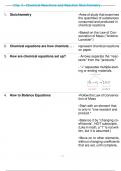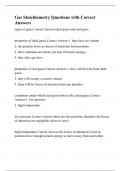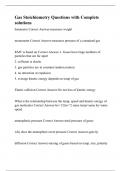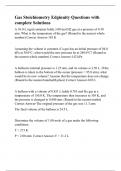Stoich - Study guides, Class notes & Summaries
Looking for the best study guides, study notes and summaries about Stoich? On this page you'll find 257 study documents about Stoich.
Page 4 out of 257 results
Sort by
Chp. 3 - Chemical Reactions and Reaction Stoichiometry
Gas Stoichiometry Questions with Correct Answers
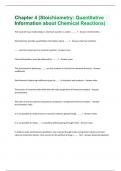
-
Chapter 4 (Stoichiometry: Quantitative Information about Chemical Reactions) Questions And Answers With Latest Updates
- Exam (elaborations) • 4 pages • 2024
- Available in package deal
-
 PatrickKaylian
PatrickKaylian
-
- $7.99
- + learn more
The study of mass relationships in chemical reactions is called ₋₋₋₋₋₋₋ ? - Answer-stoichiometry Stoichiometry provides quantitative information about ₋₋₋₋₋ ? - Answer-chemical reactions ₋₋₋₋₋ must be conserved in a chemical reaction - Answer-mass Chemical Equations must be balanced for ₋₋₋₋₋₋ ? - Answer-mass The stoichiometric balancing ₋₋₋₋₋₋ are the numbers in front of the chemical formulas - Answercoefficients Stoichiometric bala...
EDAPT STOICHIOMETRY QUIZ WITH CORRECT ANSWERS| 2024
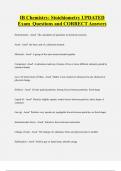
-
IB Chemistry: Stoichiometry UPDATED Exam Questions and CORRECT Answers
- Exam (elaborations) • 6 pages • 2024
- Available in package deal
-
 MGRADES
MGRADES
-
- $7.99
- + learn more
Stoichiometry - Ans The calculation of quantities in chemical reactions Atom - Ans the basic unit of a chemical element. Molecule - Ans A group of the same atoms bonded together Compound - Ans A substance made up of atoms of two or more different elements joined by chemical bonds Law of Conservation of Mass - Ans Matter is not created nor destroyed in any chemical or physical change
Gas Stoichiometry Practice Questions with Complete Solutions
Gas Stoichiometry Questions with Complete solution
EDAPT STOICHIOMETRY QUIZ WITH CORRECT ANSWERS| 2024
Gas Stoichiometry Edginuity Questions with complete Solutions
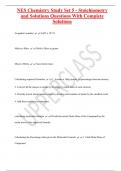
-
NES Chemistry Study Set 5 - Stoichiometry and Solutions Questions With Complete Solutions
- Exam (elaborations) • 7 pages • 2025
-
 StuviaTutors
StuviaTutors
-
- $9.99
- + learn more
NES Chemistry Study Set 5 - Stoichiometry and Solutions Questions With Complete Solutions Avagadro's number 6.022 x 10^23 Moles to Mass Mold x Mass in grams Mass to Moles mass/molar mass Calculating empirical formulas 1. Assume a 100g sample, so percentages become masses, 2. Convert all the masses to moles by dividing by molar mass of each element 3. Find the lowest whole number ratios by dividing each number of moles by the smallest result 4. Add these numbers as subscripts

How much did you already spend on Stuvia? Imagine there are plenty more of you out there paying for study notes, but this time YOU are the seller. Ka-ching! Discover all about earning on Stuvia

